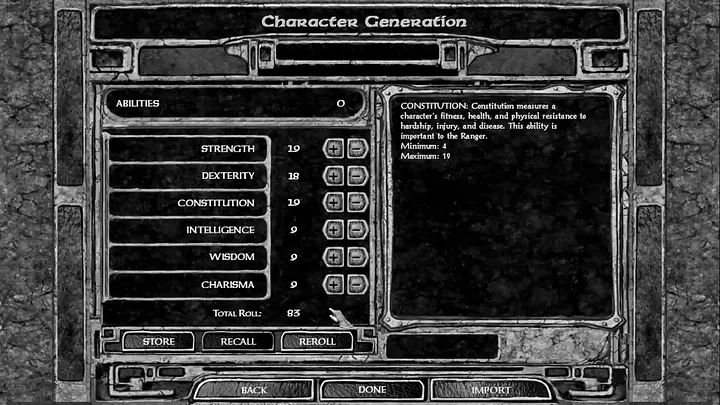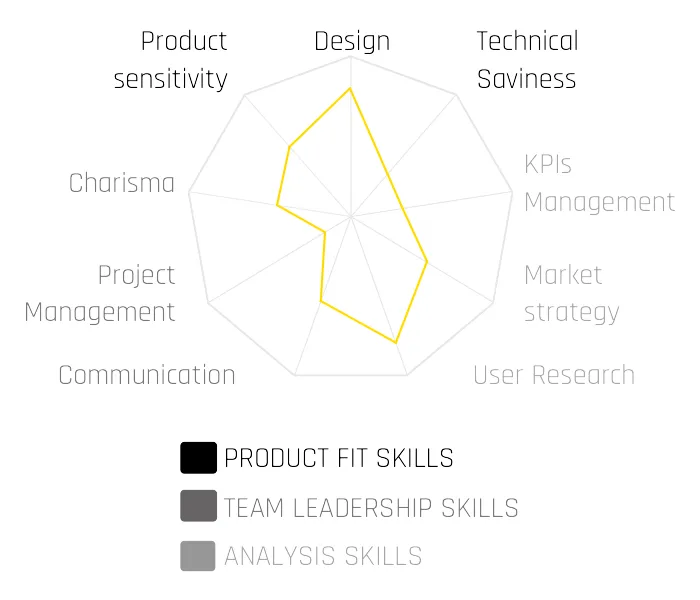Product Management (PM) is a job with a confusing and evolving definition. Plus, the role varies a lot from one industry to another. Even if we only considered digital products and a startup environment, while variation is reduced, we still find many different schools and styles. A lot has been written about the meaning of this role, such as the classic from Ken Norton, “How to hire a Product Manager”, (perhaps the most famous) and John Cutler’s “The evolving PM role” one of my recent favourites.
I’m going to give a different point of view of the PM role: what skill to look for/develop as a PM. This post should be useful if you either want to start or grow as a PM, if you’re hiring one, or are just curious.
Let’s start by sharing how I picture most professional profiles, even risking that some HR specialist reads this barbaric approach, or exposing myself as the nerd that I am.
In many RPGs (Role Playing Games), there are skill points that we have to distribute among different skills in order to configure our character when we are creating it. Even before this step, just by selecting race (e.g., orc, human or elf) we get a different base for our skill points (elves have a higher dexterity baseline, for example, and orcs have higher strength simply for being elves or orcs). When faced with the skill points distribution, do I want my elf priestess with more dexterity and less constitution? Am I willing to further lower my berserker orc’s charisma so I can increase his strength? There are always trade-offs because total skill points are more or less the same when a character is created — pure luck can give you some extra skill points or take some away. Additionally, as you progress in the game and experience points (XP) are gained, we receive extra skill points that we can again assign to the skills of our choice (i.e. we can develop our strength or charisma during the game).

Character generation in Baldur’s Gate. Bioware, 1998.
Now imagine we have a PM instead of a berserker orc or an elf priestess. My point is that we also have skills and some skill points distributed amongst them. A PM has points for a set of skills that depends on their background (elf or orc / engineer or biologist) and the way they chose to develop throughout their experience. That’s how I see myself as a PM and the PMs I have had the pleasure to know during the past few years. In the same way that we have berserker orcs who will smash your head with a hammer but aren’t suited for commercial negotiations, we also have priestess elves highly specialised in healing and bow shooting that would certainly be dead in a close range combat. In the same way, and caricaturing profiles to an extreme, we can have super tech savvy and scrum purist PMs that won’t come with groundbreaking ideas for your product, or a user-research centric, extra creative PM that can’t lead a tech team.
Every PM has his or her own abilities and it’s unusual to find one that has developed all of them fully. It is your duty as a PM to know which kind of PM you can and want to be. It is your responsibility as person looking for PMs to know which kind of PM you need. In this post I’m going to share, in a subjective and inevitably non-exhaustive way, the skills among which PMs’ skill points are distributed.
I like to say there are 9 PM skills divided in three groups:
- Product fit: technical savviness, design and product sensitivity.
- Team leadership: charisma, project management and communication.
- Analysis: KPIs management, market strategy, user research.
I’m now going to try and define all 9 skills, illustrating them with extreme examples so this is clearer and not as harsh:
Product fit
Technical savviness: the ability to understand technical complexity associated with any digital product. Do they ignore what an API is, or do they code in Rails all of the MVP’s backend by pulling an all-nighter?
For a start, this depends a lot on the PM’s background. We can simplify it into three different levels: Arts background, non computer science engineers / mathematicians / physicians and development background PMs. Of course everything can be learnt after college. I’ve had the pleasure of working side by side with a great PM in charge of a really complex recommendation system whose college background was in History!
Design: we don’t need PMs that can create pixel-perfect high-fidelity views — the trend of PM and designers as converging roles is a topic for another post — but rather in the UX side of design. UX can be broadly understood as the design of the full experience of a user with a product or service: usability, accessibility and the pleasure received by interactions with it. This definition of UX seems, among the hundreds of definitions that exist, one of the most empty and least polemic — great, since the definition of UX isn’t something we want to get into right now.
Does a PM solve everything by adding new sections to your hamburger menu or do they make wireframes with more flow than Meek Mill? As with most skills, you would need a PM to have a certain level of strength in this skill depending on the composition of your team. For instance, if you have designers fresh out of a graphic design degree, you would need a PM with strong UX knowledge that can even do prototyping. On the other hand, if you have senior product designers, or even UX designers in your company, you could afford a less UX-oriented PM.
Product sensitivity: this skill is the hardest to define. Plus, it is also difficult to develop: you either have it or you don’t. Perhaps the easiest way to define what product sensitivity is by the signs that indicate that someone has it. Someone, not necessarily a PM, with product sensitivity is always first in sharing a new app that they like and, within a few weeks, is acknowledged as a reference; is capable of suggesting 3–5 obvious improvements after testing a product for 10 minutes and asking 2 good questions, has product insights that seem obvious when said but that you didn’t come up with before or is capable of noticing product details (like small animations) that no one else sees.
Team Leadership
Charisma: a PM has to, as well as inspiring and transferring enthusiasm, have a good relationship with everyone in the company. Being nice is not enough, they have to invest time in getting people within the company on their side. It is not about gaining the favour of the CEO at any cost, but rather being able to talk about the game Journey with that “influencer” developer or extracting informal but valuable feedback from a marketing guy over some beers (probably more valuable than what you would get from a formal feedback meeting). PMs should develop a vast network within the company with several stakeholders — sales, marketing, ops, etc. — in order to build a successful product. On top of that, bear in mind that a PM has to lead a team — with developers, QA, designers, etc. — without any hierarchic relationship with them.
Project Management: whether the project management duties rely officially on the PM or not — for instance they may be amongst the engineering manager’s responsibilities. Every PM has, to a greater or lesser extent, project management tasks, because they are a reference for the rest of the company in terms of deadlines and roadmap. In this skill we include the level of knowledge of agile methodologies, roadmap and expectations management, the tool set for achieving a good throughput with the tech team or making the correct trade-off between delivery, scope and quality.
Communication: understood as the ability to express, both in writing and orally, with clarity, precision and conviction. Three examples of how important pure communication skills are for a PM:
- User stories or Product Requirement Documents should be well-written, exhaustive and clear because the quality of the product partly depends on it.
- The PM may have to communicate — with both visual and text elements and with the constraint of a simple landing page — what a product is, its advantages and how it works.
- They have to present and explain complex problems in a simplified way to very different audiences — from a tier 1 international VC to the latest addition to the Customer Success team — and, more importantly, convince them.
Analysis
Key Performance Indicators (KPIs) Management: One of my favourite skills. I love the quote wrongly attributed to Drucker: “If you can’t measure it, you can’t improve it”. It is true that analytics can have more or less impact on the company performance, depending on the maturity of the team, and that intuition also plays a role in product development, but a PM must, at least, understand the KPIs that define the success of its own product, how the released changes affect performance and be able to investigate potential problems in greater depth by setting hypothesis and validating/discarding them with data analysis. On top of that, if they understand business KPIs better, they are able to link business and product KPIs even better. Doing complex analysis, with or without the assistance of a BI analyst, is another plus.
Product strategy: how capable is a PM of
- Understanding the business model, the company strategic positioning and its business plan.
- Staying up to date in the competition’s products, reference apps or trends in both technology and design — this is useful, for example, to avoid reinventing the wheel and focusing on where the company can be truly innovating and add real value.
User research: the talent for making the most of both the external and internal users’ feedback. Besides knowing the different tools — and their advantages and disadvantages — for getting direct feedback from external users (focus groups, interviews, personas, surveys, etc.) or internal (I’m referring to people from sales, marketing, customer support, etc), this skill is related with the ability to put oneself into different types of users’ positions and understand their behaviours, use cases and motivations.
Continuing with the video games metaphor, have you ever played Pro Evolution Soccer? Don’t worry, you don’t need to. They used a very graphic way of representing players’ strengths and weaknesses: a spider chart. It is a graphic way of displaying multivariate data where each spoke represents a variable — in our case, skills. The length of the data representation on the spoke is proportional to the magnitude of the variable. In the following example, you can find a spider chart where Buffon is represented: low in attack and high in defence.

Lineup in Pro Evolution Soccer 3 (yes, the one with Collina in the cover). Konami, 2004.
In the same way, we can represent PMs’ skill set in the 9 discussed variables in a spider chart like this one below:

Let’s end by doing an exercise:
If you are a PM this exercise may help you plan which skills you need to improve.
- If you only have 20 skill points to distribute among the 9 skills discussed, what would your spider chart look like?
- If you could use another extra 5 points, where would you like to improve?
If you are looking for a PM this exercise may help you decide which profile you should source and what traits you have to look for in the interview phase:
- If you have to define the ideal PM for your company with 20–25 points, what would the spider chat look like? Bear in mind than a PM with 20 points, so he or she will also be more expensive.




